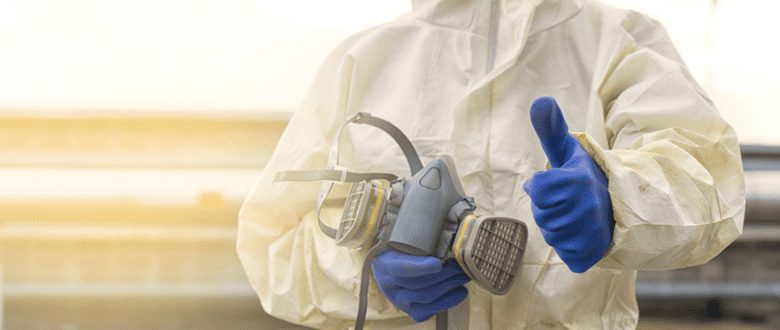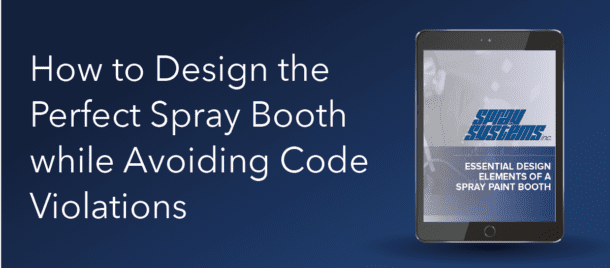Installing a spray paint booth on a factory floor requires compliance with regulatory and design requirements. Spray booth design takes into account safety and environmental factors. Due to the volatile organic compounds (VOCs) in paint, additional federal and state regulations apply to the spray paint booth’s design.
To keep personnel safe and environmental damage minimized, modifications to the building are sometimes necessary. Wet sprinkler lines, electrical connections, and exhaust ducting are common areas for which modifications to the building may be required. Building permits, air pollution permits, and compliance with federal regulations are necessary requirements during spray paint booth construction. Take a look below, where we’ll address the four common regulatory authorities and their impact on the booth design.
Local Building Requirements
Although regulations will differ between regions, many states and local areas will require a building permit for the installation of a spray paint booth. Utility connections (usually water and electrical) must comply with local regulations.
Additionally, some booth designs may require a mechanical interface to the building, such as a roof curb or roof opening. Spray paint booths mechanically interface with the building, which may necessitate modifications to the building itself.
For example, Santa Cruz County lists which building modifications are exempt from permits. Most of these exempted items are free-standing additions (i.e. a water tank or prefabricated pool) or repairs to non-essential structures, such as fences and accessory buildings. However, spray paint booths are integrated into the building itself. Under Santa Cruz guidelines and many other areas, a building permit would be required for the installation of a spray paint booth.
Air Pollution Compliance
The volatile organic compounds in paint are heavily regulated by local and federal agencies, therefore, the design of spray paint booths is also regulated. VOCs are a pollutant, as defined by the Environmental Protection Agency (EPA). However, an air pollution permit may or may not be required—it is dependent on the level of VOC emissions.
The number of pounds of VOCs emitted can be calculated from the Material Safety Data Sheet (MSDS) of the paint, which lists the amount of emissions per gallon used. Paint operations under a certain threshold may be exempt from a permit. However, painting processes that require a booth are likely to exceed this minimum threshold.
For example, the Ohio EPA reports that operations emitting less than 10 lbs of VOCs per day do not require pollution permitting. However, emissions should still be tracked to verify compliance with the amount allowed. Many factory painting operations exceed this minimum threshold. In this case, a Permit to Install and Operate (PTIO) is required. Regulations differ from state to state, so make sure to check your area’s regulations with local authorities.
Fire Prevention
The VOCs present in many paints present an environmental, as well as fire, hazard. Spray paint booth operations must take fire prevention and personnel safety into account.
Fire safety design requirements impact electrical connections, ventilation requirements, and fire protection systems, such as sprinklers. While state and local regulations vary, the National Fire Protection Association (NFPA) standard can provide a good reference point. NFPA 33 provides specific design requirements for spray applications using flammable materials and even the types of allowable filters in the booth design are noted.
Designing for fire safety is a key element of spray paint booth construction.
Safety of Personnel
Fire prevention and minimizing pollutants are intended to reduce risks to factory personnel. However, there are additional federal requirements regarding spray paint booth operators. Many are covered under OSHA 1910.107—a standard that impacts the airflow, emergency egress, paint storage, filter maintenance, and much more.
The Occupational Safety and Health Administration (OSHA) requires an average airflow of 100 linear feet per minute. Gauges and alarms that sound when the airflow is not maintained must also be installed. This one requirement determines much of the spray paint booth’s design characteristics—even the amount of illumination is specified so that the lighting fixtures do not present a hazard. Although these standards may seem cumbersome, they are crucial to the design of a safe and successful spray paint booth.
As booth design experts, we are constantly balancing the manufacturer’s finishing needs and regulatory demands. The VOCs present in paint has necessitated heavy regulation because fire danger and environmental damage must be minimized at the design level.
A safe and effective booth must take local, state and federal regulations into account during the design process. To accomplish the final booth design, a building permit for the necessary modifications is also typically needed. These permits and regulations tend to make spray booth design and installation feel like a small construction project – put your trust in the hands of the experts; Spray Systems will ensure a quality booth solution, one that meets all regulations, and that’s right for you.
Make sure your spray booth meets regulations and contact the spray booth experts at Spray Systems.

